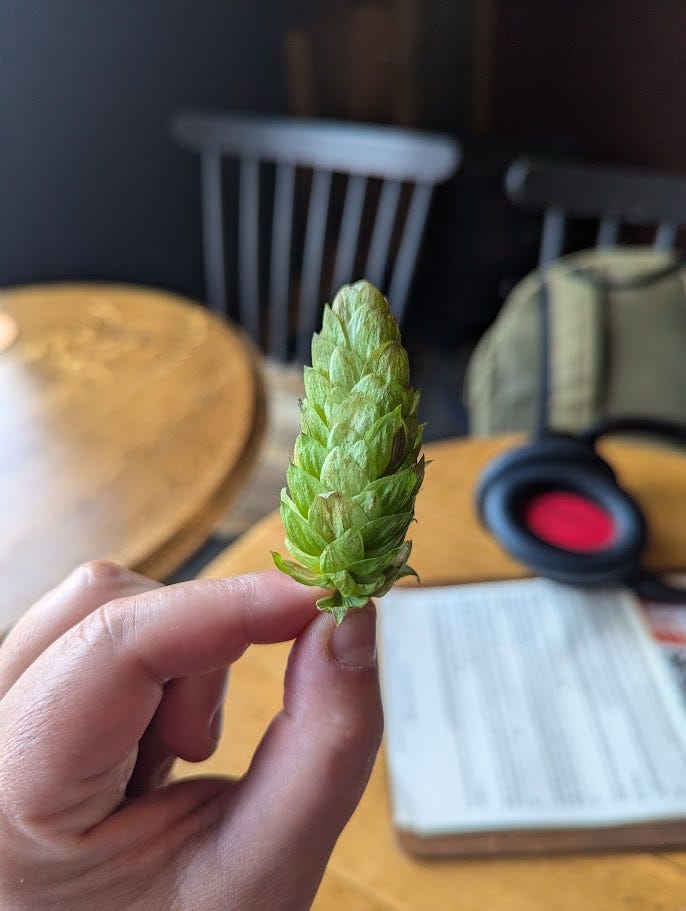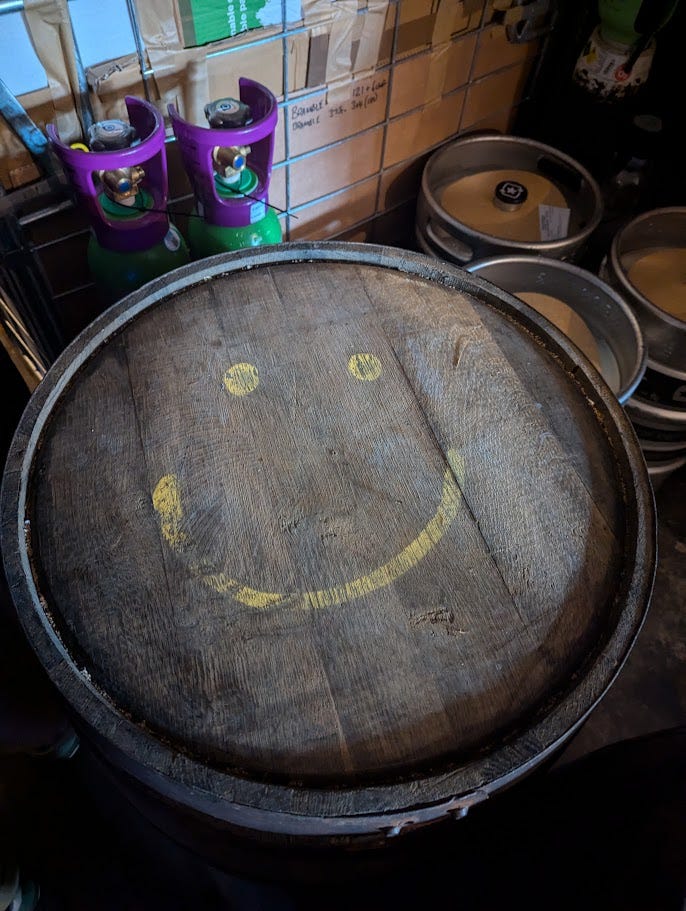A wine-lover's guide to blended and wild beer
There's a world of fascinating wild, blended and farmhouse beers out there to drink. But I guess you need to know what they are, first.
This piece was originally written for Glug magazine earlier in 2024. To sign up for their excellent wine club, visit their website.
I’m sitting on the stony ground of a vineyard high above the Mosel river. In the warm evening sun, German winemaker Jas Swan hands me a bottle of Braueri Kemker mixed fermentation beer from the back of her van to pour my own generous measure into my mug. As the sun sets over the Mosel valley, and Simba the border collie runs riot around the vines, I sip and wonder. Why is a winemaker drinking beer?
Braueri Kemker are one of Germany’s new-wave farmhouse breweries, so-called because their beers and their recipes are based on the rusticity and tradition of farmhouse brewing, a technique that involves using naturally-occurring yeasts and bacteria to create unique flavours and aromas within the beer. If this sounds familiar, it’s because many wines are made this way. Some say it’s a major component of terroir—the yeasts providing localised character unavailable anywhere else. Many winemakers, Jas included, are fans of these types of beers because not only are they delicious, they share her winemaking values—they are complex and balanced, they are made with care and precision, and they have a definitive sense of place.
“It makes sense to me, because I think there are definitely comparisons between wine and blending beer,” says Will Harris, co-owner, brewer and blender at Balance Brewing and Blending in Manchester. “Particularly in our process—we use wine barrels to age our beer, so there’s a physical connection to wine too.”
Not every brewer uses wine barrels to make their beer. This extra step is how blended, farmhouse, and aged beers are left to rest, just like wine, in order for their flavours to mellow and the character of the wood to mingle with the beer. At Balance Brewing and Blending, their barrels come from a range of winemakers, using American oak for vanilla notes just as a winemaker would for their Chardonnay, and making use of the flavours left behind from the barrels’ previous occupants.
“One thing that runs through the whole process is the fact that our beer is made from moments,” says James Horrocks, who co-owns and runs Balance Brewing and Blending with Will. Unlike other beers, you have the fermentation in barrels, then the blending moment, then bottle conditioning or kegging that changes the evolution of the beer. It creates this idea of “you are having this beer right now, it will never be like this again.” There’s something really exciting about that.”
There’s romance in blended and wild or farmhouse beers that a wine lover could appreciate. Just as James feels each bottle of his beer is a once-in-a-lifetime, transient experience, you’ll hear the same story from top vignerons, their wines expressing a moment captured in time. What’s more, their attention to the agriculture of their produce has definite crossover—how is that moment in time created without the influence of the grapes, or the yeast, or barley, for that matter? Many mixed fermentation and blended beers are made with fruit, the most famous being kriek, which is a beer made with cherries. For brewers, the addition of fruit opens up another dimension of flavour profiles, and for the drinker, it once again offers an easy side-step into the world of wine. Balance Brewing and Blending create fruit beers using locally-sourced and waste fruit, and use winemaking techniques such as carbonic maceration to gather flavour and texture from the fruit they use, and breweries like Cantillon and 3 Fonteinens use seasonal fruit and even flowers to produce their beers. Cantillion’s elderflower beer “mamouche” is sought after every single year, the floral aroma mingling perfectly with the tart, acidic flavours of the lambic beer.
As a wine lover, these are the beers that could set your soul on fire. Yes, wine drinkers do occasionally enjoy a cold lager on a sunny day, or a pint of Guinness at the pub. But it’s these carefully crafted beers that pay homage to their provenance that elevate them from being simple thirst-quenchers. If you love wine because it gives you flavours to explore and lots to think about, give blended, wild, and mixed-fermentation beers a chance to shine for you. You might be surprised at how much crossover there is.
“We’re looking at similar kinds of flavours as in natural wines—funk, Brettanomyces, and acidity as creators of flavour,” says Will. “Some of the character that is actually conveyed from the barrel…and because of the nature of the barrels, you can grasp some of those oxidative notes and characters too. Fino sherry and our dry saisons have a really nice flavour crossover, some of that umami and minerality, and definitely some of the structure.”
For Will, and for me too, the way these beers progress in the glass is what makes them stand out. Unravelling the nuances within the beer, just as you might with wine, gives you the full picture of this beer’s making—from the grain to the glass.
“Drinking it is an experience—evolving, mingling, and changing. It’s evocative, it’s thoughtful, it goes beyond just taste,” Will says.
Top restaurants are starting to see the fascination with blended beers, using their complex characters and unusual, unique flavours to complement and contrast with adventurous dishes on tasting menus. Chefs like Tom Barnes of Skoff in Manchester, and Mark Birchall at two Michelin star restaurant Moor Hall in Ormskirk, Lancashire are including blended and mixed-fermentation beers on their wine lists and tasting menus. You may be offered one at your next meal. I wholeheartedly hope you accept a glass, and enjoy it for what it is—not wine, but a beer that can be just as special.
Types of Mixed Ferm and Blended Beers
Saison: A light, dry, historic beer from Belgium that’s sometimes sour, and pretty hard to sum up in one sentence.
Lambic: A traditional Belgian style. Very tart.
Gueuze: A blend of lambic of different ages, which is then further aged. Complex and tart. The brewery’s approach to “Grand Cru”.
Kriek: Lambic aged on cherries.
Mixed-Fermentation: Sour beer made by mixing yeast and bacteria for specific end results. Fruit can be added. Almost a catch-all term for all of the above (but not always.)







